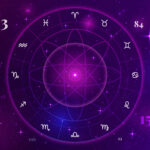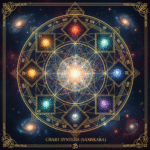Table of Contents
What’s the astrological secret to gaining wisdom, influence, and a respected place in the world? In the profound system of Vedic astrology (Jyotish), such blessings often arise not from a single planet’s strength alone, but from a special synergy between planets – a ‘Yoga‘. These specific planetary combinations are like hidden codes within your birth chart, pointing towards unique potentials and life paths. Understanding these formations unlocks a deeper layer of astrological interpretation. This article focuses on one of the most celebrated and auspicious of these combinations, the gaja kesari yoga, revealing how this potent Jupiter-Moon connection is formed and the remarkable results it promises.
Astrological Yogas: The Chart’s Deeper Language
Before diving into the specifics of Gaja Kesari, let’s briefly touch upon Yogas. In Jyotish, a Yoga signifies a distinct planetary alignment created by the placement, association (conjunction), or aspect between planets in a natal chart. These planetary yogas act like specific circuits, shaping how planetary energies manifest to produce particular life outcomes. Think of them as the underlying combinations in astrology that reveal potentials ranging from significant challenges (Duryogas) to great success (Raja Yogas or Dhana Yogas). Understanding these yogas is fundamental to deciphering the nuanced promises within a horoscope.
Gaja Kesari Yoga: The Elephant-Lion’s Auspicious Blend
(Opinion): The Gaja Kesari Yoga is widely regarded as one of the most fortunate and beneficial yogas in Vedic astrology. Often translated as the “Elephant-Lion” combination, it primarily bestows wisdom, intelligence, eloquence, virtue, lasting fame, and significant influence, which naturally lead to prosperity and high status.
(Reason): Why is this jupiter moon yoga so highly esteemed? Its power comes from the auspicious Kendra (angular) relationship between the two great natural benefics: Jupiter (Guru) and the Moon (Chandra). Jupiter, the ‘Gaja’ (Elephant), represents profound wisdom, knowledge, expansion, fortune, wealth, and righteousness. The Moon, the ‘Kesari’ (Lion), represents the mind, emotions, public influence, nourishment, and quick thinking.
When these two planets, who are natural friends, are placed in mutually supportive angular positions (1st, 4th, 7th, or 10th from each other), they amplify each other’s best qualities. Jupiter’s expansive wisdom provides depth and ethical grounding to the Moon’s mental and emotional faculties.
In turn, the Moon’s influential nature gives practical application and public reach to Jupiter’s profound knowledge. This combination creates a personality that is both deeply intelligent and emotionally resonant, learned and influential.
(Example): An individual blessed with a strong gaja kesari yoga often embodies this harmonious blend. They might be a respected judge known for fairness and wisdom, a charismatic teacher beloved by students, a successful and ethical business leader, or a highly regarded advisor whose counsel is sought by many.
Their Jupiterian knowledge is expressed through their Lunar ability to connect with and influence people. They often possess natural oratory skills, a positive reputation, and the ability to navigate challenges with grace and intelligence. Think of a public figure admired equally for their sharp intellect and their genuine compassion.
(Opinion/Restatement): Therefore, while often linked to wealth, Gaja Kesari Yoga is primarily a yoga of profound wisdom and beneficial influence. The resulting prosperity, fame, and status are the natural consequences of these core qualities manifesting effectively in the world. It’s a yoga indicating success achieved through intellect, virtue, and positive public standing.
Formation Rules: Identifying Gajkesari Yoga
(Pattern Spotting): How do you pinpoint this powerful combination in a birth chart? The classical rule for identifying Gajkesari Yoga is clear and specific:
Gaja Kesari Yoga is formed when Jupiter is placed in a Kendra (angular house) from the Moon.
Let’s break down the steps:
- Locate the Moon: Identify the house where the Moon is positioned in the natal chart.
- Locate Jupiter: Identify the house where Jupiter is positioned.
- Check the Angular Relationship: Count the houses from the Moon’s position to Jupiter’s position (inclusive). Is Jupiter in the 1st, 4th, 7th, or 10th house from the Moon?
- 1st House from Moon: Jupiter and Moon are conjunct (in the same house).
- 4th House from Moon: Jupiter is four houses away from the Moon.
- 7th House from Moon: Jupiter is seven houses away (directly opposite) the Moon.
- 10th House from Moon: Jupiter is ten houses away from the Moon.
If Jupiter occupies any of these angular positions relative to the Moon, the gajkesari yoga is formed. The Kendra houses (1, 4, 7, 10) are considered the foundational pillars of the chart. When the two great benefics occupy these mutually supportive positions, they strongly influence each other and activate their positive potential across the individual’s life.
Interpreting the Results: The Blessings of Gaja Kesari
(Value): What specific outcomes does a well-formed Gaja Kesari Yoga promise? Classical Vedic texts attribute numerous highly favorable results to this combination. A person possessing this gajkesari yoga is said to be:
- Intelligent and Wise: Endowed with Jupiter’s vast knowledge, learning capacity, and sound judgment.
- Eloquent and Persuasive: Able to communicate effectively and influence others positively through speech (a quality enhanced by the Moon’s connection to the public).
- Virtuous and Noble: Guided by Jupiter’s inherent righteousness, possessing strong moral character and ethical conduct.
- Famous and Reputed: Earning a lasting positive reputation and achieving recognition within their community or chosen field. The Moon strongly influences public image.
- Wealthy and Prosperous: Attracting financial abundance and enjoying material comforts, often as a result of their wisdom and influence. Jupiter is the natural significator of wealth (Dhana Karaka).
- Overcomes Enemies/Obstacles: Possessing the intelligence (Jupiter) and mental resilience (Moon) to successfully navigate challenges and defeat adversaries (often through diplomacy rather than force).
- Associated with Authority: Likely to be respected by or connected with people in positions of power.
- Charitable and Generous: Reflecting the expansive and benevolent nature of Jupiter.
In essence, this yoga suggests a life path where intellect and emotions are harmoniously blended, leading to success that is both materially rewarding and ethically sound. The individual often leaves a positive and lasting legacy.
Mythbusting: Why Does My Gaja Kesari Yoga Seem Weak?
(Engagement): Here we arrive at the crucial point of practical application. You might identify this yoga in your chart – perhaps Jupiter sits perfectly opposite your Moon – and wonder why you aren’t yet a renowned sage or rolling in wealth. This is because the simple presence of the yoga is merely the first layer of analysis. The strength and quality of the gaja kesari yoga are what truly determine the potency and visibility of its results. Many charts contain the basic structure, but its full promise only flowers under specific conditions. Here’s why your jupiter moon combination might feel less impactful:
- Planetary Strength (Shadbala & Dignity): How inherently strong are Jupiter and the Moon?
- Exaltation/Own Sign/Moolatrikona: Are they exceptionally strong by sign placement (e.g., Jupiter exalted in Cancer, Moon exalted in Taurus or in its own sign Cancer)? This dramatically boosts the yoga’s power.
- Debilitation: If either planet is debilitated (Jupiter in Capricorn, Moon in Scorpio) without a strong cancellation (Neecha Bhanga Raja Yoga), the Gaja Kesari Yoga is significantly weakened or may even give contrary results.
- Combustion: Is the Moon too close to the Sun (generally within 12 degrees)? Combustion weakens the Moon considerably. Jupiter can also be combust, though it requires closer proximity.
- Other Dignities: Placement in friendly signs is good; placement in enemy signs weakens them.
- House Placement (From the Ascendant): Where do Jupiter and the Moon fall in the main chart?
- Auspicious Houses: If both planets (or at least the stronger one) occupy Kendra (1, 4, 7, 10) or Trikona (1, 5, 9) houses from the Ascendant, the yoga strongly influences core life areas positively.
- Dusthana Houses (6, 8, 12): If Jupiter or the Moon (especially the weaker one) falls in these challenging houses from the Ascendant, the benefits of the yoga can be obstructed by conflicts, health issues, sudden setbacks, or losses, even though the angular relationship exists between them. The results become mixed.
- Aspects (Drishti): Are other planets influencing Jupiter and the Moon?
- Benefic Aspects: Aspects from Venus or a strong Mercury can add further grace, intelligence, or refinement to the yoga’s expression.
- Malefic Aspects: Aspects from Saturn, Mars, Rahu, or Ketu can significantly modify or obstruct the results:
- Saturn: Can cause delays, frustrations, or limit the scope of success, demanding immense perseverance.
- Mars: Can add impulsiveness or aggression to the communication or actions, potentially leading to conflicts despite the underlying wisdom.
- Rahu: Can amplify the desire for fame and wealth, potentially leading to unconventional or even unethical means; can create fluctuations.
- Ketu: Can bring detachment from the results, sudden insights, or success in more esoteric or spiritual fields rather than purely material ones.
- Condition of the Moon: The Moon’s phase (waxing is generally preferred over waning, especially a dark Moon) and its overall condition are critical, as it forms the reference point for the yoga. A weak or afflicted Moon weakens the foundation.
- Dasha Timings: The full effects of Gaja Kesari Yoga are most powerfully experienced during the Mahadasha (major periods) and Antardashas (sub-periods) of Jupiter and the Moon. If these periods occur at an opportune age and the planets are strong, the results will be prominent.
Therefore, simply identifying the angular placement is insufficient. A thorough analysis requires evaluating the individual strengths of Jupiter and the Moon, their placement from the Ascendant, the aspects they receive, and the timing of their planetary periods within the context of the entire chart.
Conclusion: A Symphony of Wisdom and Mind
The Gaja Kesari Yoga is a beautiful example within yogas vedic astrology of how the synergy between two benefic planets can create a potential for a life marked by wisdom, influence, respect, and prosperity. It represents the auspicious alignment of knowledge (Jupiter) with the mind and public influence (Moon).
However, as the mythbusting section highlights, its mere presence is not a guarantee. The intricate web of strengths, weaknesses, placements, and influences within the entire horoscope determines the true potency of this celebrated jupiter moon combination.
Discovering a gajkesari yoga in your chart is certainly promising, but understanding its specific strength and how it interacts with the rest of your unique astrological blueprint requires careful consideration. It offers a glimpse into a potential path paved with wisdom and influence, a path that, when activated under favorable conditions, can lead to a truly fulfilling and respected life.











